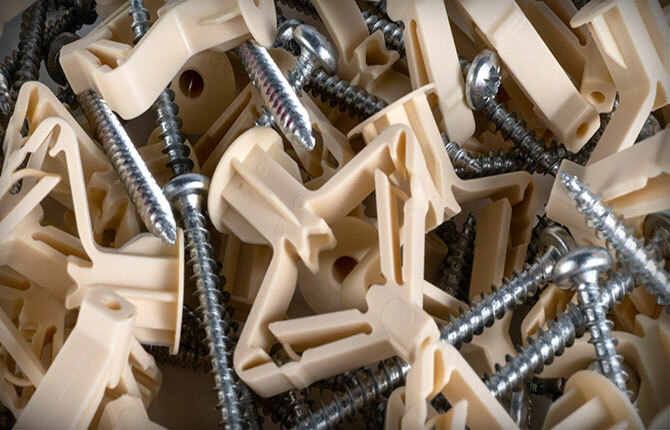Given the characteristics of the foamed concrete material, choosing an aerated concrete dowel is not as easy as it might seem at first glance. There are many models, each has advantages and disadvantages.
Aerated concrete is a capricious material, and what is forgiven if fasteners are installed on brick or expanded clay concrete can be a serious mistake with consequences for an aerated concrete block.
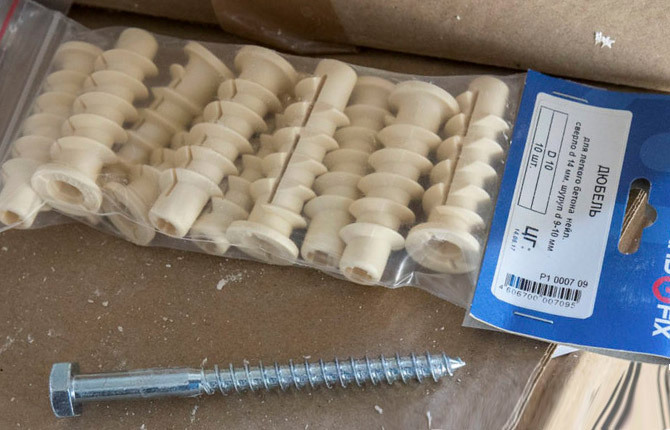
The content of the article:
- Requirements for fasteners for aerated concrete
- Types of dowels
-
Overview of the best dowels
- Self-tapping screw
- Universal
- Specialized
- Professional
- Non-standard solutions
Requirements for fasteners for aerated concrete
Of all types of wall blocks, aerated concrete requires the most thorough preparation for the future installation of fasteners. The material is soft, it is easy to cut it with a hacksaw or drill a hole with a conventional drill with a pen drill. But easy machinability turns into a negative when it comes to securely fixing the dowel inside the foamed cement-sand mass. The strength of aerated concrete is low. A small plate can be broken or crushed by hand.
Therefore, the design of the mount and specifically the dowel must meet 2 conditions:
- Low specific pressure on the surface of aerated concrete.
- Uniform distribution of pressing forces from the plug-dowel.
The holding strength of the dowel can be provided by washers or reverse cones. But the depth of their embedding (immersion) in aerated concrete should be sufficient to avoid chipping and cracking of the material.
One of the problems of aerated concrete is the fragile edge of the hole for the dowel. Therefore, some types of dowel plugs are simply hammered into the gas block even without pre-drilling. All self-tapping screws of the dowel type, as well as dowel-screws, are installed inside aerated concrete without drilling a hole.
Selection for you:
- Dowel for brick
- Types of dowels for foam block
- Which dowel to choose for drywall
Types of dowels
For fasteners on aerated concrete, you have to use long self-tapping screws with a diameter of 6-12 mm, a length of 120-180 mm, without plugs. This option is possible for walls made of gas-filled concrete up to 50 cm thick. In other cases, fasteners with enlarged plugs, plastic screws of large diameter, as well as special design dowels with drop-down petals are used.
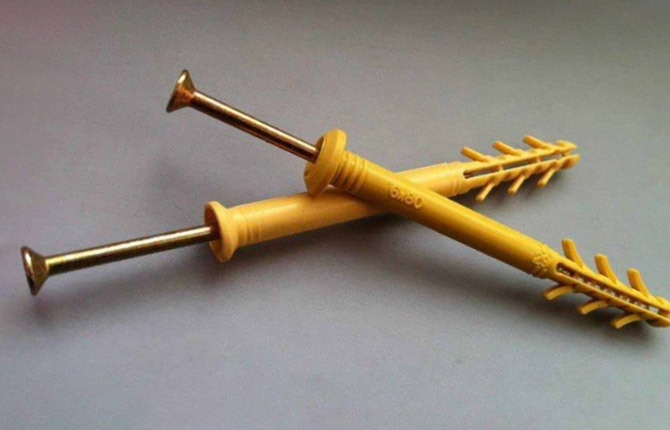
The entire range of fasteners for aerated concrete blocks is conditionally divided into several groups by design. Screws, self-tapping screws and dowels, screwed in without plugs.
Fasteners inside the gas block are held solely by the helical spiral on the surface of the rod:
- classic dowel inserts;
- plastic dowel plugs with an additional notch on the surface;
- specialized dowels for aerated concrete;
- PBT screws;
- chemical anchor.
The latter option for blocks is used only in exceptional cases due to the high cost of fasteners. One package is enough for several installation points, but the cost of a resin bottle is about 20 times more than even conventional plugs and 10 times more than specialized high-strength models. Therefore, it makes sense to buy a chimanker only for situations where there is no other way to make particularly strong fasteners.
For mounting on aerated concrete, dowels or screws with a protective coating can only be used. The composition of the aerated concrete mixture includes lime, it is used as one of the gas-forming agents. After the porous mass has set, part of the lime remains in the mixture and “eats” the fastening metal.
Therefore, for aerated concrete, models with a plastic or nylon plug are more often used. It can be long - from 120 mm to 150 mm.
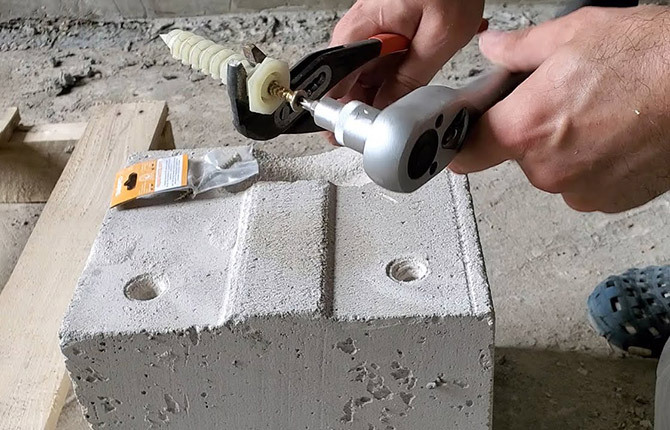
For internal walls made of aerated concrete, short dowel-plugs in the form of a cone with a feathered or helical surface are also used. The immersion depth of such a plug-dowel is from 30 to 50 mm.
In addition, for hanging heavy objects, such as kitchen furniture, specialized spacer models with a reverse cone are often used. This is the only type of dowel that is not afraid of vibrations and does not lose its bearing capacity even under shock loads.
Facade dowels are usually installed on the outer surfaces of aerated concrete walls. Cork material securely seals the hole in the wall and prevents moisture from penetrating inside.
Overview of the best dowels
Aerated concrete is massively used both as blocks for masonry and for wall insulation. The density of the cellular mass for different brands of gas block is very different. The heaviest blocks have small pores. Such material is used for the construction of walls. According to their characteristics, they resemble poplar wood.
For such aerated concrete, you can use traditional fasteners - the same pins or screws with a large winding. In this case, the dowel-plug can be taken.
Self-tapping screw
It is possible to fasten on aerated concrete without a dowel, if the density of the block is high. How to determine the suitability of aerated concrete? Just hammer an ordinary nail into the wall with a hammer. It should enter the material of the block, like a tree, not fall into the material strongly with each blow of the hammer.

If the aerated concrete has passed the test, then you can select the mount. If you mount it without a cork, then it is best to use the famous Finnish SORMAT screws with a flat head.
Fastener characteristics:
- diameter 10 mm;
- length 185 mm;
- slot Torx 40;
- zinc coating.
The peculiarity of the screw is the specific shape of the spiral. She has a reverse. Such a scheme provides easy "entry" of fasteners and high resistance to pull-out load.
SORMAT can be used as a lightweight fastener. Pull-out load resistance is only 15 kg, shear load resistance is as much as 25 kg. This is enough to fix a shelf with a total weight of up to 15 kg on aerated concrete with a couple of SORMATs.
Very small items can be mounted on an aerated concrete wall using self-tapping screws with a wide screw knurling and a large “hat”. Fasteners can be screwed directly into aerated concrete or installed using an additional dowel, usually nylon or polypropylene.
Due to the specific shape of the “thread”, the self-tapping screw cuts deeply into the body of aerated concrete. Despite the short length of the helical spiral, the strength of the fasteners is sufficient to fix a small object weighing up to 5 kg on aerated concrete.
Universal
Small items can be fixed to aerated concrete using universal dowels. Typically, such a mount is used on internal walls made of gas block. The thickness of the pier does not allow installing full-length fasteners, so shortened fasteners are used.
As a rule, the best dowels recommended for use on aerated concrete have additional ribs and notches on the surface. They enhance the grip and prevent the fastener from turning while the screw is being tightened.
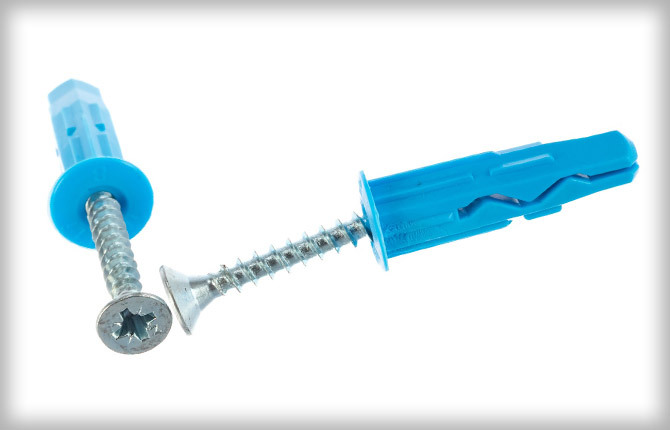
For aerated concrete, dowel plugs with a specific surface shape are used.
For main walls made of aerated concrete, it is better to use models with an elongated plug and a screw. In such a self-tapping screw, the helical knurling-spiral on the rod is made along the entire length, almost to the very head.
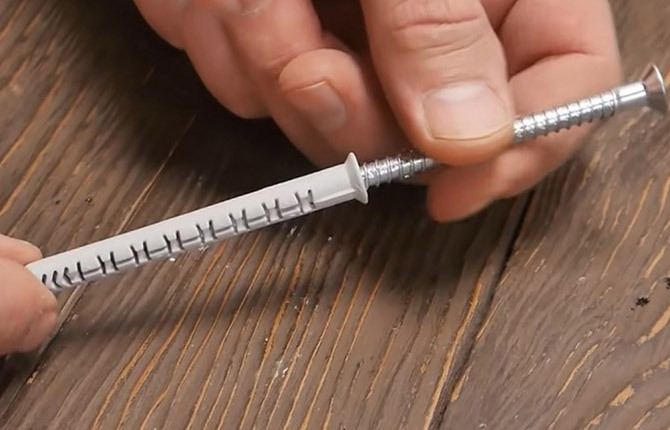
The design of the plug-dowel is somewhat different from the usual universal models. The cork is almost twice as long. This makes it possible to increase the maximum load on the fasteners.
The surface of the cork is “cut” in such a way that the plastic remains smooth until it is installed inside the gas block. And only after the screw is tightened, the rod squeezes the spikes out, they "bite" into the aerated concrete and fix the insert inside the block well.
If a short dowel is required for aerated concrete, then split models with annular one-sided notches are better kept. The profile of such notches is asymmetrical, the slope is made towards the hole. As a result, the plug easily enters and hard to exit the gas block.
Specialized
This type of dowel includes models specially designed for installation on aerated concrete.
The most popular model with protruding ribs twisted at an angle like a spiral. The fastener was designed specifically for installation in foam concrete and aerated concrete. It is believed that such a cork made of nylon can withstand a load of up to 150 kg.
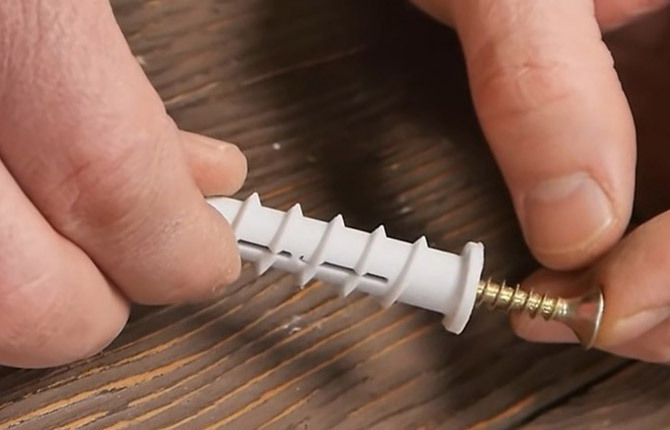
But the average value for aerated concrete brand D500, D600, that is, for wall blocks. For the more common brand D400, the resistance of the dowel inside aerated concrete is 15-20% lower. The most popular sizes are 10x60 mm and 14x80 mm.
Installation of the dowel-spiral is carried out only with preliminary drilling of the wall. The hole diameter is selected 1 mm less than the minimum bushing diameter. This part of the plug is made conical, with a pronounced transition to the cone in the back. Hammer the hole in. And you have to hit the dowel hard.
Sometimes they try to put a spiral dowel on D600 aerated concrete without taking into account the resistance of the wall material. Hitting too hard can break the helical ribs on the dowel. Therefore, if fastening is required on heavy aerated concrete, it is better to use more balanced plug models.
For example, a metal dowel-sleeve, known as a "crocodile". The steel sleeve with 4 longitudinal cuts and perforated edges has a slight taper. This means that after drilling, inserting the dowel into the hole will be relatively simple. With your fingers, you can simply stick the dowel in half, hammer the rest into aerated concrete.
The surface of the "crocodile" is profiled so that when the screw is screwed inward, the sleeve petals will unbend and cut into aerated concrete with teeth and extruded waves. In general, the mount sits quite firmly inside the gas block. It can withstand a pulling load of up to 220 kg and is second only to another specialized dowel - a driven spacer made in Germany.
This is one of the most durable and reliable fastening systems for a gas block. It is used mainly on medium and heavy aerated concrete. In this case, the pull-out load resistance reaches 350 kg. On light gas blocks, it is used less frequently, since the material often cracks during installation.
The design consists of 3 elements:
- Steel reinforced bushing with split petals.
- Bolt with nut and washer.
- Slider with threaded insert.
For installation, you need to drill a hole with the diameter indicated on the sleeve. Next, the plug-dowel is inserted by hand and hammered into the aerated concrete, like a regular nail. Now you need to rotate the bolt head, pull the slider and start the dowel petals. This is not a reverse cone, but the fastening strength is obtained, as for aerated concrete, a record, 300-400 kg. Only professional facade dowels can compete with this model.
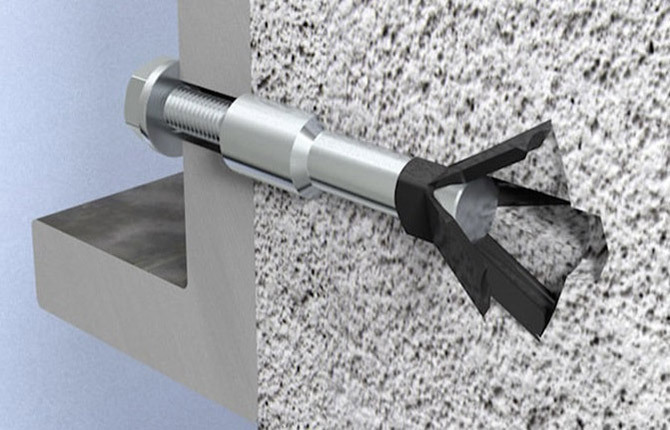
The only drawback of the model is its price. It is about 7-8 times higher than that of conventional dowels for aerated concrete blocks.
Professional
The front dowel is huge in size. The length and diameter of the cork are 150 mm and 12 mm, respectively. With proper installation, fasteners are able to withstand heavy loads - up to 360 kg. But at the same time, the price for facade models is about three times less than for a German expansion dowel.
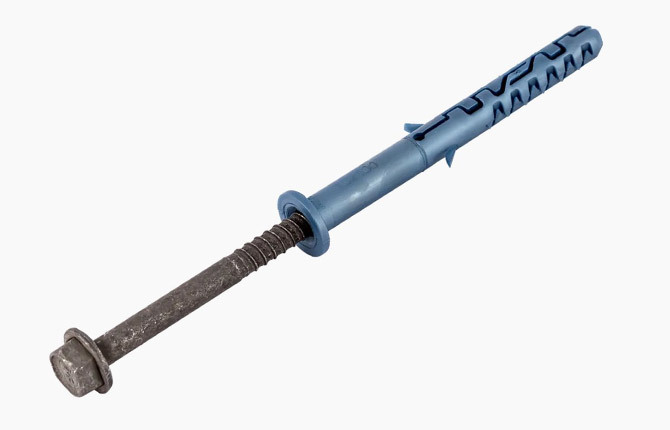
Facade fasteners are installed according to the standard scheme - a hole is drilled for the cork, a plastic sleeve is hammered in and the bolt is tightened. The scheme is simple, effective, but used mainly by professionals. For amateur tasks inside the house, you can take fasteners easier and cheaper.
For example, a screw dowel-plug RVT. This is a cylindrical plug-dowel with a regular helical spiral. A cut is made along the axis. This allows the plastic to deform when the screw is screwed in.
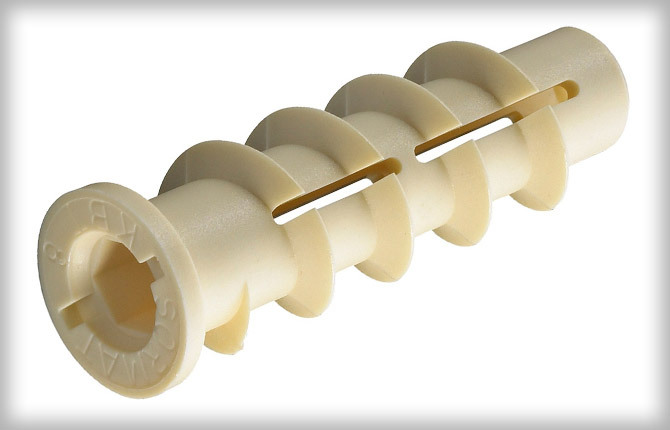
This model compares favorably with a cork with ribs in a simpler installation scheme. It is enough to drill a hole in aerated concrete 1 mm smaller than the diameter of the central sleeve, insert and screw the dowel with a screwdriver.
The screw dowel is considered more durable, "hardy" and reliable. For example, a “screw” with a size of 10x50 mm with an M4 screw can withstand a pull-out load of up to 300 kg. But only on aerated concrete brand D500. On lighter grades, the strength is reduced to 250 kg.
There is a modification of the screw dowel. This is a self-adjusting dowel plug for fixing on drywall. It has the same shape, but slightly smaller. But there is a difference - a feather drill is made on the nose.
It turns out that this type of dowel fastener works great on light grades of aerated concrete. No drilling is required for mounting the dowel. It is enough to put the cork on a cross-shaped bit for a screwdriver, turn on the “shurik” and wrap it in the gas block until it stops. But the dowel will gain full strength only after screwing in the self-tapping screw.
The strength of the fastener is relatively small. For example, for a 32x14x5mm cork, the pull-out load is only 50 kg. It may not be much, but for lightweight aerated concrete, installation speed is often more important than safety margin.
Another type of gas block dowel used by professionals is shown in the photo. It does not look like any familiar type of dowel fastening.
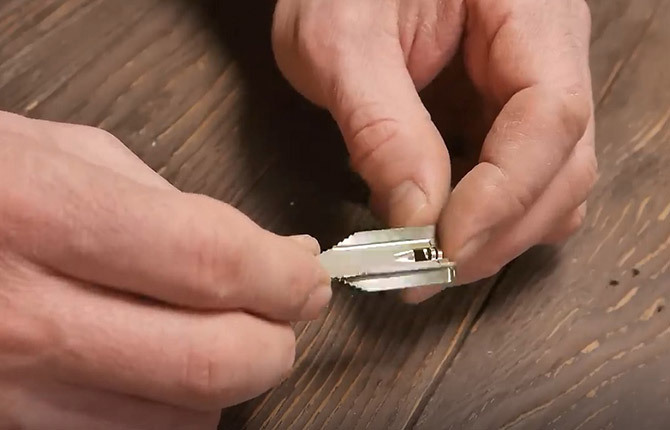
In its design, it resembles a blade, but it is a full-fledged dowel for aerated concrete. It consists of two plates welded into a flat package, there is a perforated hole in the center. A self-tapping screw is screwed into it.
The dowel is driven into gas-filled concrete without pre-drilling, like a regular nail. This type of fastener is designed for installation for medium and light grades of aerated concrete D400. It is not easy to hammer such fasteners into heavier material, you will have to hold the plate with your hands until the dowel enters the body of the gas block at least a third. The metal dowel will simply fall out of lightweight aerated concrete, since the bursting action from the wrapped self-tapping screw will not be enough for reliable fixation.

Despite its simple appearance, the dowel-nail can withstand a heavy load - up to 150 kg for pulling out and 110 kg for cutting. Plus the cost is not more than 5 rubles apiece. But there is one limitation, the dowel-nail is recommended to be used exclusively on internal walls made of aerated concrete.
The reason is that when fasteners are driven into cellular concrete, part of the protective coating is erased, covered with deep scratches, and the metal begins to rust. Sometimes so hard that rust spots appear on the surface. And although manufacturing companies claim that this only increases the strength of the fasteners in the wall, it is still better to use the dowel nail indoors. If you had to use it on exterior walls, then you need to put it on any colorless varnish or paint.
Non-standard solutions
The range of dowels for gas blocks is not limited to universal, specialized and professional types of fasteners. For example, on gas-filled concrete, you can use a new type of plastic fasteners designed for installation on external walls made of foam blocks.

This is a screw anchor. It consists of an external anchor with a diameter of 18 mm and an 8 mm stud screwed into it. The anchor is made of polyamide (nylon) reinforced with fiberglass. Therefore, fasteners withstand a large load of twisting and stretching. If, according to the project, it is necessary to fix insulation or a membrane on the wall of gas blocks, then the dowel is put on a rondole cover.
The standard length of the dowel-anchor is 18 cm, but shorter versions of 50 mm and 70 mm can be used for conventional fastenings.
The main advantage of the anchor dowel i is the high strength of the fastener. For aerated concrete brand D600 - 400 kg, for D300 - 140 kg.
Another option for non-standard fasteners is a thermoplastic dowel. This is a variation of the usual one, but the design uses a fusible (polyethylene) plug-dowel. In terms of size and structure, it is no different from most plastic corks, only a special fire-retardant coating is applied on the surface.
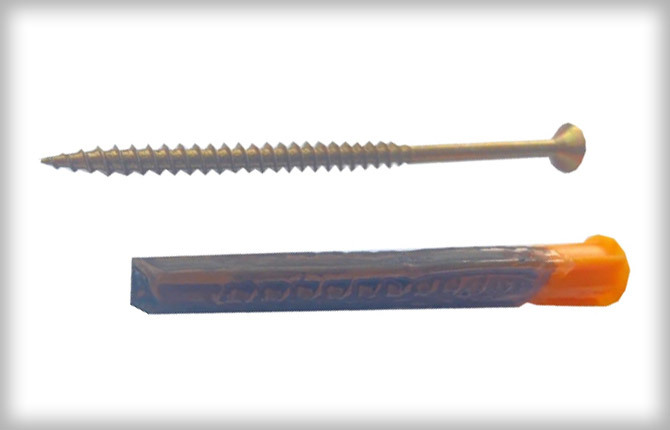
To install, you need to drill a gas block to a depth of 70 mm and a diameter of 8 mm. After that, the cork is heated with a lighter for 10-12 seconds and inserted into the hole. While the plastic is soft, the dowel must be besieged with a hammer and a nail wrapped in it.
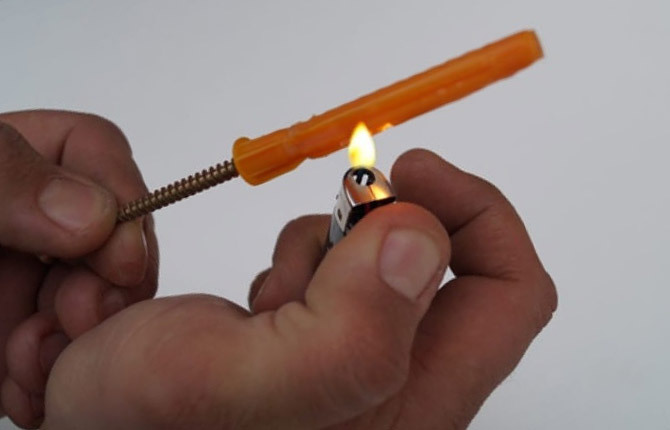
This scheme is used mainly for thin walls made of aerated concrete, where it is impossible to install standard dowels with plugs of 120-150 mm.
For heavy aerated concrete, it is not difficult to choose a dowel, you can use all types of fasteners for foam blocks or expanded clay concrete. The situation is much more complicated with a light gas block. In this case, the cork and screw must be selected individually, focusing on the characteristics of the wall.
Tell us about your experience in choosing and installing dowel fasteners. What models, in your opinion, can be considered the most successful for a gas block?
